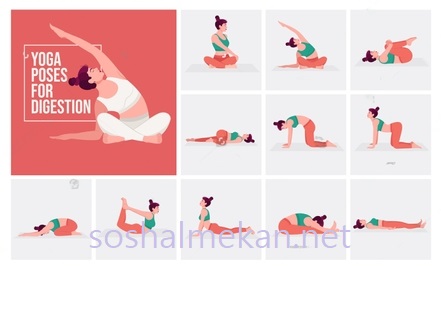A Complete Guide to Prenatal Yoga: Nurturing Body and Mind Through Pregnancy
Congratulations on your pregnancy! As your body embarks on this incredible journey, prenatal yoga can be a wonderful companion, offering physical and mental benefits throughout each trimester. Here's your personalized guide to yoga for your five-month-old bun in the oven, divided into three parts:
 |
A lady doing prenatal yoga pose in garden |
Part 1: Prenatal Yoga in the First Trimester (Weeks 1-13)
This trimester can be a rollercoaster of emotions and changing physical sensations. Nausea, fatigue, and breast tenderness are common. Your prenatal yoga practice should focus on gentle movements, fostering mindfulness, and cultivating inner peace.
Warm-up:
- Cat-Cow: Begin on all fours, hands shoulder-width apart and knees hip-width apart. Inhale, arch your back like a cow, dropping your belly and looking up. Exhale, round your back like a cat, tucking your chin and engaging your core. Repeat 5-10 times.
- Neck Rolls: Slowly roll your head in a circular motion, first clockwise, then counterclockwise, 5 times each direction.
- Gentle Arm Circles: Extend your arms out to the sides at shoulder height and make small circles forward and backward, 5 times each direction.
Main Practice:
- Modified Tadasana (Mountain Pose): Stand tall with your feet hip-width apart, root down through your feet, and lengthen your spine. Hold for 5 breaths.
- Side Stretches: Stand with your feet hip-width apart and reach your arms up overhead. Lean gently to one side, reaching your hand down your leg as far as comfortable. Hold for 5 breaths, then repeat on the other side.
- Seated Cat-Cow: Sit on a chair or bolster with your knees bent and feet flat on the floor. Follow the same breathing pattern as Cat-Cow on all fours, focusing on spinal movement.
- Butterfly Pose: Sit on the floor with the soles of your feet together and knees open towards the butterfly wings. Gently press your knees down with your elbows and lean forward, keeping your back straight. Hold for 5 breaths.
- Supported Savasana (Corpse Pose): Lie on your back with a bolster or pillows under your knees and head for extra comfort. Close your eyes and focus on your breath, letting your body completely relax. Hold for 5-10 minutes.
Cool-down:
- Child's Pose: Rest on your knees with your toes together and sit back on your heels. Fold your torso forward and rest your forehead on the floor or mat. Hold for 5-10 minutes.
- Deep Breathing: Lie on your back in Savasana and practice slow, deep belly breaths. Inhale for a count of 4, hold for 2, and exhale for a count of 6. Repeat for 5 minutes.
Tips for the First Trimester:
- Listen to your body. Modify or skip poses that feel uncomfortable.
- Avoid deep twists and poses that compress the abdomen.
- Limit lying on your back for extended periods.
- Stay hydrated and consult your doctor before starting any new exercise program.
Part 2: Prenatal Yoga in the Second Trimester (Weeks 14-28)
The "honeymoon phase" of pregnancy often arrives in the second trimester. You may have increased energy, improved nausea, and a growing belly. Your prenatal yoga practice can now incorporate more strengthening and balancing poses while maintaining a focus on mindful movement.
Warm-up:
- Sun Salutations: Practice a modified Sun Salutation sequence, focusing on gentle backbends and lunges. You can use a chair or block for support in poses like Downward-Facing Dog.
- Warrior I and II: Stand in a lunge position with your front knee bent at 90 degrees and your back leg straight. Hold Warrior I with your arms raised overhead, then transition to Warrior II with your arms outstretched, parallel to the ground. Hold each pose for 5 breaths and repeat on the other side.
- Side Plank: Start in high plank, then shift your weight onto one elbow, stacking your hips and shoulders. Hold for 5 breaths and repeat on the other side.
Main Practice:
- Modified Boat Pose: Sit on the floor with your knees bent and feet flat, then lean back and lift your legs off the ground, supporting your weight with your arms. Hold for as long as comfortable, lowering your legs gradually.
- Tree Pose: Stand on one leg with your foot rooted to the ground and the other foot resting on your shin, calf, or inner thigh. Hold for 5 breaths and repeat on the other side.
- Bridge Pose: Lie on your back with your knees bent and feet flat on the floor. Lift your hips off the ground, engaging your core and glutes. Hold for 5 breaths, then slowly lower down.
- Cat-Cow with Leg Extensions: On all fours, inhale and arch your back as you extend one leg back. Exhale and round your back, bringing the knee back to chest. Repeat on the other side, 5 times each.
- Seated Twist: Sit on the floor with your legs crossed. Place your right hand on your right knee and your left hand behind you on the floor. Twist your torso towards the left, looking over your shoulder. Hold for 5 breaths, then repeat on the other side.
Cool-down:
- Supported Child's Pose: Place a bolster or pillows under your belly and thighs for extra comfort. Fold forward and rest your forehead on the floor or mat. Hold for 5-10 minutes.
- Legs-Up-the-Wall Pose: Lie on your back with your legs up against a wall. Relax your arms and breathe deeply. Hold for 5-10 minutes.
Tips for the Second Trimester:
- You can gradually increase the intensity of your practice, but maintain a mindful approach.
- Pay attention to your balance and modify poses as needed.
- Be aware of your changing center of gravity and stay grounded in your poses.
- Focus on strengthening your core muscles to support your growing belly.
Part 3: Prenatal Yoga in the Third Trimester (Weeks 29-40)
As your due date approaches, your belly may feel bulky and your movements may become slower. Embrace the transformative nature of this trimester through gentle stretches and restorative prenatal yoga poses. Focus on inner peace and preparation for labor.
Warm-up:
- Gentle Neck Rolls and Shoulder Circles: Slowly roll your head in a circular motion and make small circles with your shoulders, forward and backward, 5 times each direction.
- Modified Cobra Pose: Lie on your stomach with your elbows bent and hands supporting your upper body. Gently lift your chest and head off the mat, keeping your neck long. Hold for 5 breaths.
- Seated Cat-Cow: Sit on a chair or bolster with your knees bent and feet flat on the floor. Follow the same breathing pattern as Cat-Cow on all fours, focusing on spinal movement.
Main Practice:
- Supported Pigeon Pose: Place a bolster or pillows under your right buttock and fold your left leg under your torso. Rest your forehead on your hands or a block near your folded leg. Hold for 5 breaths, then repeat on the other side.
- Wide-Legged Forward Fold: Sit with your legs wide apart and fold forward, resting your head on the floor or a block between your legs. Hold for 5-10 breaths.
- Supported Reclined Bound Angle Pose: Lie on your back with your knees bent and feet together. Place a strap or belt around your arches and gently pull your feet towards you. Rest your arms alongside your body or on your belly. Hold for 5-10 minutes.
Cool-down:
- Supine Savasana: Lie on your back with your arms alongside your body and palms facing upwards. Close your eyes and focus on your breath, letting your body fully relax. Hold for 10-15 minutes.
- Guided Meditation: Practice a guided meditation specifically designed for preparing for childbirth. Visualize a calm and peaceful birth experience.
Tips for the Third Trimester:
- Prioritize restorative poses that ease discomfort and promote relaxation.
- Focus on mindful breathing and visualization exercises to prepare for labor.
- Listen to your body and take breaks whenever needed.
Remember, yoga is a journey, not a destination. Enjoy the process and celebrate your body's incredible transformation.
This guide provides a basic framework for prenatal yoga throughout your pregnancy. Remember to personalize your practice to your individual needs and preferences. Always consult your doctor before starting any new exercise program, especially during pregnancy.
May your yoga journey be one of deep connection, physical well-being, and inner peace throughout your pregnancy and beyond.
If You Have Yoga Experience,
Okay, my mindful mama-to-be! Since you have yoga experience, let's tailor your prenatal practice to ensure both safety and maximum benefit.
Here's 6 Things, what to avoid:
- Deep twists: They compress your abdomen and potentially strain your abdominal muscles.
- Poses on your belly: Lying flat on your stomach puts pressure on your baby. Opt for modified versions like side-lying poses or Sphinx pose.
- Full backbends: Avoid deep extensions like Upward-Facing Dog or Wheel Pose, as they can strain your back and put pressure on your abdominal wall.
- Inversions: Handstands, Headstands, and Shoulder Stands are not recommended because of the shift in blood flow and potential balance issues.
- Strong abdominal engagement: Crunches, planks, and similar poses can strain your abdominal muscles and potentially contribute to diastasis recti.
- Hot yoga: The high temperatures can be dehydrating and uncomfortable for you and your baby.
Now, let's flow into 6 amazing yoga poses:
- Cat-Cow: This classic warms up your spine and encourages mindful breathing. Modify by keeping your knees on the floor for extra comfort.
- Modified Warrior II: Stand with a wider stance and lean forward slightly, focusing on strength and balance.
- Side-lying Leg Lifts: Strengthen your glutes and core while lying on your side with support under your head.
- Supported Bridge: Build pelvic floor strength and open your chest with a block or bolster under your sacrum.
- Seated Spinal Twists: Gently twist your torso with one hand on your knee and the other behind you, keeping your spine long.
- Supported Savasana: Relax and recharge with pillows or bolsters under your knees and head, letting go of any tension.
Bonus tip: Incorporate mindful breathing throughout your practice, focusing on inhalations through your nose and exhalations through your mouth. This calms your mind and promotes deeper relaxation.
Namaste!
#prenatalyoga #pregnancyyoga #yogamom #yogababy #fitpregnancy #healthypregnancy #wellbeing #mindfulness #selfcare #momtobe #strongmom #pregnancyexercise #exerciseforpregnancy #trimestertips #prenatalfitness #fitandfabulous #yogaeveryday #yogalife #namaste #blessed
6 FAQs about the Prenatal Yoga Guide:
1. Is it safe to do yoga throughout pregnancy?
Generally, yes! Prenatal yoga offers numerous benefits for both body and mind during pregnancy. However, it's crucial to consult your doctor before starting any new exercise program, especially during pregnancy.
2. What poses should I avoid during pregnancy?
Deep twists, poses that compress the abdomen, and lying flat on your back for extended periods should be avoided. Listen to your body and modify or skip any poses that feel uncomfortable.
3. How often should I practice prenatal yoga?
Aim for 2-3 sessions per week, with each session lasting around 30-60 minutes. However, even shorter sessions can be beneficial, and it's important to listen to your body and practice at your own pace.
4. What modifications should I make for each trimester?
The guide already suggests modifications for each trimester based on your growing belly and changing center of gravity. Remember, the focus should be on gentle movements, mindfulness, and inner peace.
5. Can I use props in my prenatal yoga practice?
Absolutely! Bolsters, pillows, blocks, and straps can offer support and comfort in many poses. Use them to modify poses and make your practice more enjoyable.
6. Where can I find more resources for prenatal yoga?
There are numerous online resources, studios offering prenatal yoga classes, and qualified instructors who specialize in working with pregnant women. Explore different options and find what works best for you.

.png)





